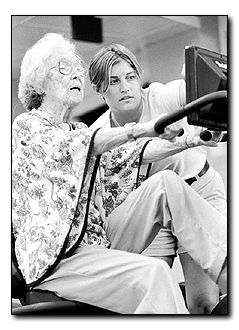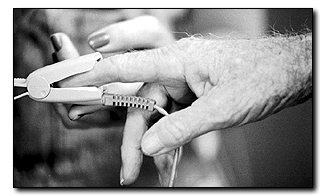![[ NEWS ]](/images/fall97/newsf97.gif)
![]()
By Greg Clark
Arizona Daily Wildcat September 9, 1997
An exercise in life
![[Image is Loading. No, Really, it is.]](07_1_i.gif)
Chris Richards Helen starts out slowly on the treadmill, coached on the left by Sharon Arkin, a clinical researcher in Speech and Hearing Sciences, and head of the program. On Helen's right is her close friend, Jean Short, who has come to cheer her on. |
It is a well-established medical fact that regular exercise improves cardiovascular
function and can be beneficial in treating heart and respiratory ailments.
The link between physical fitness and Alzheimer's disease is more of a mystery.
A study at the University of Arizona is attempting to discern the effects exercise has on memory loss associated with Alzheimer's disease.
Sharon Arkin, a clinical researcher in the UA's Department of Speech and Hearing Sciences, is launching a study to find out whether concentrated physical and mental exercise can help rehabilitate sufferers of Alzheimer's disease, or at least slow the progression of the disease.
The study, which is being funded by a five-year, $395,000 grant from the National Institute on Aging, will follow 14 people in the early stages of Alzheimer's.
The research subjects, ranging in age from 57 to 86 are paired with student, volunteers and started on an exercise program.

Chris Richards Carolyn Bland, a speech and hearing sciences senior, works one-on-one with Helen Crawford, 83, who suffers from Alzheimer's disease, explaining equipment in the UMC Health and Wellness Center. |
Arkin hopes to determine if a regimented exercise program and regular contact with student assistants can help slow the mental decline into Alzheimer's dementia.
She plans to compare test results and observations of her study group with a national sample study of Alzheimer's sufferers who were monitored, but received no treatment or intervention.
Three times per week, the 14 subjects of her research will be taken through a program of aerobic and strength conditioning at the University Health Sciences Center's Employee Wellness Center.
They will be monitored as they exercise on treadmills and stationary bicycles, and five weight machines, including leg, chest and overhead presses.
Once per week, each subject is assisted by a student partner, and family members assist in the other two weekly visits, Arkin said.
Over the weekend, Arkin introduced three research subjects, student partners and several family members to the exercise equipment at the Wellness Center.
Reactions from the subjects were mixed.
Martin Develin, who will be 86 later this month, said he had little use for the program.
"I don't need exercise, not in my arms. I farmed for 22 years or more, and outside of walking, I just don't need it."
Eighty-year-old Dorothy Cook went about the machines with vigor.
"I've been here a couple of times and it's a lot of fun," she said.
Heather Lang, a speech and hearing sciences senior, is helping 80-year-old Al Boyd with his fitness program.
Boyd, a retired professional musician, seems to enjoy getting out and interacting with people, Lang said.
"He really likes it, likes people and he's funny," she said.
As with many Alzheimer's patients, though his long-term memory is clear, he cannot remember recent events.
"He can remember what he got for Christmas when he was 5 years old, but he can't remember what he had for breakfast," Lang said. "We have been to the gym eight or nine times, but he still says, he doesn't want to push it, since it's his first time."

Chris Richards Helen's pulse is taken to safely gauge the intensity of the exercise. As part of a study at UMC, called Elder Rehabilitation by Students, she engages in a physical exercise in the hopes that it will offset effects of the disease. |
Lang said working with Boyd has been uplifting because she can see the difference she can make helping people.
According to Bruce Coull, head of the UA's department of neurology, Alzheimer's disease affects more than 2.5 million Americans.
"The incidence of Alzheimer's disease increases by decade. Around age 60, the incidence is 10 percent. By age 80 or so, the chance increases to one in three," Coull said.
It is now known that Alzheimer's disease is caused by the growth of specific lesions in the brain, said UA psychologist Alfred Kaszniac, who has been conducting Alzheimer's research for 20 years.
The lesions are growths of either one of two dense proteins, which commonly deposit in areas of the brain responsible for memory, language function and spatial recognition abilities, Kaszniac said. "We now know something about the synthesis of these proteins and how they develop."
A great deal of today's research is focusing on how to disrupt the neurochemical processes that cause these lesions, he said.
For most Alzheimer's sufferers, the disease begins with memory difficulty, Kaszniac said. As time goes on, it causes problems with language and the ability to express words. It can also lead to trouble with spatial relationships, causing patients to become easily lost and disoriented.
In the later stages, sufferers lose their ability to recognize objects, Kaszniac said. "People may not be able to recognize a toothbrush as a toothbrush, and may not even recognize family members. Eventually people become completely immobile, and that is usually the fatal stage of the disease," Kaszniac said.
Arkin first became interested in the relationship between exercise and disease when she saw studies that suggested exercise programs in nursing homes benefited residents.
"There seems to be evidence that exercise reverses the progress of osteoporosis, I wondered how it would affect Alzheimer's patients."
In addition to exercise, Arkin's research includes specialized memory and language training for nine of the 14 Alzheimer's patients.
Students will work with the patients to stimulate conversation, Arkin said.
She believes simple social interaction may have some benefit for Alzheimer's sufferers, whose memory deficiency makes personal contact difficult.
During weekly meetings with their partners, students will ask questions about the patient's opinions, Arkin said.
"We're trying to stimulate mental activity by talking on all kinds of topics, playing word games and asking the patient's interpretation of proverbs," she said.
Students will also help patients make "memory books" and "memory tapes."
"Alzheimer's patients really don't learn very well, and their short-term memory is very bad," Arkin said. "We find that by making a video or audio tape emphasizing various facts or events, patients can review the information over and over, and they can eventually learn it."
Memory books are simply scrapbooks highlighting significant events and information about a person's life. Reviewing the books can often trigger memories, and aid in conversation, Arkin said.
Kaszniac, who has screened and diagnosed the pool of potential research subjects for Arkin's study, said her work is important for people involved in the treatment of Alzheimer's symptoms.
Though the physical and memory exercises will not cure the disease, they may be found to provide temporary benefit, Kaszniac said. "The psycho-social benefit of the social interaction combined with mental stimulation may be very important," he said.
Arkin is still seeking students to work in the study. Participating students are paired with research subjects, meet with and assist them in the fitness program and receive independent study credit. Interested students may contact Arkin at 760-5595.



